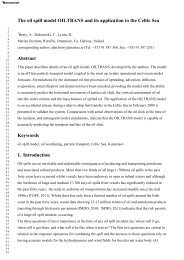Marine Industries Global Market Analysis - Marine Institute
Marine Industries Global Market Analysis - Marine Institute
Marine Industries Global Market Analysis - Marine Institute
Create successful ePaper yourself
Turn your PDF publications into a flip-book with our unique Google optimized e-Paper software.
MARINE INDUSTRIES GLOBAL MARKET ANALYSIS<br />
113<br />
22 <strong>Marine</strong> IT<br />
Definition – IT hardware and software in all aspects of marine activities. (Excludes systems not<br />
designed for specialised marine applications – e.g. typical office software.)<br />
1999–03 2004 2005–09<br />
Irish <strong>Market</strong> €M 43 18 78<br />
UK <strong>Market</strong> €M 648 217 917<br />
Europe <strong>Market</strong> €M 3,794 1,382 5,872<br />
World <strong>Market</strong> €M 9,780 3,570 16,012<br />
22.1 INTRODUCTION<br />
There are more than 500 suppliers of ‘marine computing’ worldwide (these are<br />
mainly SMEs, also there are many marine leisure sector players).<br />
<strong>Marine</strong> IT is a subject that is difficult to assign precise boundaries to. IT hardware &<br />
software applies to, and is embedded in, all aspects of marine activity so is difficult to<br />
value.The major sectors are those associated with critical ship operations (e.g.<br />
integrated bridge), equipment support (e.g. engine management) and marine<br />
operations (e.g. cargo handling).<br />
In addition there are many shore-based applications ranging from fleet management<br />
software to vessel traffic systems, and design software for various marine systems<br />
ranging from ships’ hulls to dynamic risers for floating production systems.<br />
Figure 22.1: <strong>Marine</strong> IT – Major Sectors<br />
Source: Douglas–Westwood<br />
In total, marine IT covers a very wide range of subject areas and systems including:<br />
Critical IT – Navigation, Charting, Engine Management, Systems Management,<br />
Positioning, Communication, Loading/stability,Weather Forecasting and Ocean<br />
Modeling, Data Management.<br />
Non-critical IT – ISM Code Reporting, Accident & Injury Reporting, Cargo<br />
Transactions, Fuel Reporting, Bunkering Ops, Cargo Status Reporting, Crew &<br />
Payroll, Daily Log, Engineers Log, Invoices, Manifesting, Supplies, Equipment<br />
Performance Log, Equipment Procurement, Internet, Classification Reporting,<br />
Maintenance Management, Purchasing Management, Mail,Work Systems.<br />
Other IT – Design, Build, Procurement.<br />
Office-based software – VTMS, Brokering, Engineering Procurement, Crew<br />
management, Positioning/tracking, Accounting, Data Management, Fleet<br />
Management,Vessel Scheduling, Planning & Reservation.<br />
A significant barrier to development of marine IT has been the relatively high costs<br />
of high data rate satellite communications compared with onshore hard-wire or<br />
mobiles. Substantial improvements have been made but until broadband is successfully<br />
launched by Inmarsat in 2005/06, a bottleneck will remain. It is possible that the<br />
provision of internet services for the airline industry may speed up the process and<br />
reduce costs. Boeing are entering the maritime satellite communications market,<br />
challenging the historic dominance of Inmarsat.

















